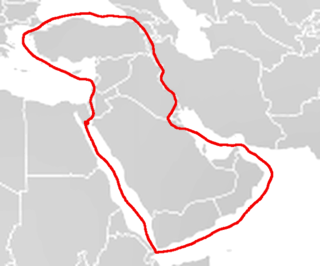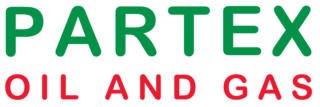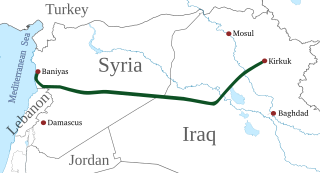There is a long history of the petroleum industry in Iraq.
Contents
- Early history: The Ottoman Empire
- Aftermath of World War I
- Iraqi Petroleum Company
- Iraq War and Post-War developments
- References

There is a long history of the petroleum industry in Iraq.

In ancient times Plutarch wrote of oil bubbling from the ground near Kirkuk, but oil exploration did not begin until the 20th century when the Ottoman Empire granted a concession allowing William Knox D'Arcy to explore oil fields in the territories which, after the dissolution of the Ottoman Empire, became the modern countries of Iran and Iraq. Though the company, called African and Eastern Concession Ltd, was unable to find oil at first, D'Arcy and other European partners founded the Turkish Petroleum Company (TPC) in 1912. [2] [3] [4]
TPC was formed with the purpose of acquiring concessions from the Ottoman Empire to explore for oil in Mesopotamia. The owners were a group of large European companies: Deutsche Bank; the Anglo Saxon Oil Company, a subsidiary of Royal Dutch Shell; the National Bank of Turkey, a British concern; and Turkish-born Armenian businessman Calouste Gulbenkian. [5] The driving force behind TPC's creation was Gulbenkian, while the largest single shareholder was the British Government-controlled Anglo-Persian Oil Company, which held 50% of the shares by 1914. TPC received a promise of a concession from the Ottoman government but the outbreak of World War I in 1914 put a stop to all exploration plans. [6] [7]
After the partition of the Ottoman Empire, the British gained control of Mosul in 1921, and the British-backed Faisal I of Iraq became the first King of Iraq. [2]

In 1925, TPC obtained a 75-year concession to explore for oil in exchange for a promise that the Iraqi government would receive a royalty for every ton of oil extracted. A well at Baba Gurgur was located by geologist J.M. Muir just north of Kirkuk. Drilling started, and in the early hours of 14 October 1927 oil was struck. Many tons of oil were spilled before the gushing well was brought under control, and the oil field soon proved to be extensive. [8]
Discovery of oil in Kirkuk hastened the negotiations over the composition of TPC, and on 31 July 1928 shareholders signed a formal partnership agreement to include the Near East Development Corporation (NEDC) — an American consortium of five large US oil companies that included Standard Oil of New Jersey, Standard Oil Company of New York (Socony), Gulf Oil, the Pan-American Petroleum and Transport Company, and Atlantic Richfield Co. (By 1935 only Standard Oil of New Jersey and Standard Oil of New York were left). [5] [9]
The agreement was called the Red Line Agreement for the "red line" drawn around the former boundaries of the Ottoman Empire (with the exception of Kuwait), and it effectively bound the partners to act together within the red line. Writer and former IPC employee Stephen Hemsley Longrigg noted that "[T]he Red Line Agreement, variously assessed as a sad case of wrongful cartelization or as an enlightened example of international co‑operation and fair-sharing, was to hold the field for twenty years and in large measure determined the pattern and tempo of oil development over a large part of the Middle East". [10] [11]
TPC shares were held in the following proportions: 23.75% each to the Anglo-Persian Oil Company, Royal Dutch/Shell, the Compagnie Française des Pétroles (CFP), and the NEDC; the remaining 5% went to Calouste Gulbenkian. [5] [7] In 1929, the TPC was renamed the Iraq Petroleum Company. [10]
Between 1925 and 1931 the government of Iraq received a lump sum payment of £400,000, but after 1931 the government was paid a royalty of 4 gold shillings per ton of crude oil produced. (This royalty was increased to six shillings in August 1950.) [12] In 1931, the Iraqi government and IPC reached an agreement for a new 70 year concession, in exchange for increased payments to Iraq and an agreement that two pipelines to the Mediterranean would be built by 1935. By this time the Mosul Oil Company was already operated by IPC, and when the company was granted a third concession in 1938 the Basrah Petroleum Company was created to develop assets in Iraq's southern regions. [2]
The Red Line Agreement lasted until 1948 when two of the American partners broke free. During the period, IPC monopolized oil exploration inside the Red Line; excluding Saudi Arabia and Bahrain, where ARAMCO (formed in 1944 by renaming of the Saudi subsidiary of Standard Oil of California (Socal)) and Bahrain Petroleum Company (BAPCO) respectively held controlling position. [10]
The first Iraqi export pipeline was built from 1932 through to 1934. It went from Kirkuk to Haditha as a twin 12-inch pipe line, which then split into a southern line to Haifa and a northern line to Tropoli, both with a capacity of approximately 45,000 bbl/day. After World War II, two new 16-inch loop lines were to be laid along the existing pipes adding an additional capacity of two times 85,000 bbl/day. In 1945, the refinery at Haifa was complete enough to process all crude arriving through both 12-inch branches, with the Tripoli portion being ferried south by tankers.
Following the creation of the State of Israel the Iraq-Haifa pipeline was shut down right at the point when its 16-inch expansion was nearing completion, and the Tripoli branch was expanded by the additional 16-inch line and then by the 30-inch Kirkuk–Baniyas pipeline. The pipelines were closed between November 1956 and March 1957 when Syrian pumping stations were destroyed during the Suez crisis, which caused a financial crisis in Iraq. Iraq could not transport its oil through the Persian Gulf while the Suez Canal remained closed, so the closure of the Mediterranean pipelines meant Iraqi oil production ground to a standstill. [12]
After Muhammad Mossadegh nationalized the oil industry in Iran, IPC agreed to accept an "equal profit sharing" arrangement in 1952. Instead of a flat royalty payment, Iraq would be paid 12.5% of the sale price of each barrel. [12] However, foreign company control of Iraq's oil assets was unpopular and in 1958 Abd al-Karim Qasim overthrew Faisal II of Iraq. After seizing control of the Iraqi government, Qasim demanded better terms from IPC but decided against nationalization of Iraq's petroleum assets. [2]
In 1961 Iraq passed Public Law 80 whereby Iraq expropriated 95% of IPC's concessions and the Iraq National Oil Company was created and empowered to develop the assets seized from IPC under Law 80. This arrangement continued in 1970 when the government demanded even more control over IPC, eventually nationalizing IPC after negotiations between the company and the government broke down. By this time the Ba'ath Party was in power in Iraq and Saddam Hussein was its de facto ruler, although Ahmed Hassan al-Bakr did not formally step down as president until 1979. [13] [14]
In February 2007, the Iraqi cabinet approved a draft law that would distribute oil revenues to the various regions and provinces of Iraq based on population, and would also give regional oil companies the authority to enter into contractual arrangements directly with foreign companies concerning the exploration and development of oil fields. Iraqis remained divided over provisions allowing regional governments to enter into contracts directly with foreign companies; while strongly supported by Kurds, Sunni Arabs wanted the Oil Ministry to retain signing power. As a compromise the draft law proposed that a new body called the Federal Oil and Gas Council would be created that could, in some circumstances, prevent execution of contracts signed by regional governments. [15] This arrangement would undo the nationalization of the Iraqi oil industry that dates back to 1972.[ citation needed ]
Under Article I of the 2010 Law of Income Taxation on Foreign Oil Companies Working in Iraq, there is a 35% tax on "income earned in Iraq from the contracts signed with the Foreign Oil Companies, their subsidiaries, branches, or offices and their subcontractors working in Iraq in the field of oil and gas extraction and production and the relevant industries". The production contracts, which foreign oil companies enter into with the Iraqi federal or regional governments, often include revenue-sharing terms as well. [2] [16]
Additionally, in the last few years oil production in Iraq has increased rapidly and seems to be headed in even more of a direction where it will be even more heavily relied on. [17]


Calouste Sarkis Gulbenkian, nicknamed "Mr Five Per Cent", was a British-Armenian businessman and philanthropist. He played a major role in making the petroleum reserves of the Middle East available to Western development and is credited with being the first person to exploit Iraqi oil. Gulbenkian travelled extensively and lived in a number of cities including Istanbul, London, Paris, and Lisbon.

The Anglo-Persian Oil Company was a British company founded in 1909 following the discovery of a large oil field in Masjed Soleiman, Persia (Iran). The British government purchased 51% of the company in 1914, gaining a controlling number of shares, effectively nationalizing the company. It was the first company to extract petroleum from Iran. In 1935 APOC was renamed the Anglo-Iranian Oil Company (AIOC) when Reza Shah formally asked foreign countries to refer to Persia by its endonym Iran.

The Iraq Petroleum Company (IPC), formerly known as the Turkish Petroleum Company (TPC), is an oil company that had a virtual monopoly on all oil exploration and production in Iraq between 1925 and 1961. It is jointly owned by some of the world's largest oil companies and headquartered in London, England. However, today it is only a paper entity with historical rights and plays no part in the modern development of Middle Eastern oil.

The Trans-Arabian Pipeline (Tapline), was an oil pipeline from Qaisumah in Saudi Arabia to Sidon in Lebanon, active between 1950–1976. In its heyday, it was an important factor in the global trade of petroleum, as well as in American–Middle Eastern political relations, while locally helping with the economic development of Lebanon. The pipeline was built and operated by the Trans-Arabian Pipeline Company, now a fully owned subsidiary of Aramco. It largely ceased functioning in the early 1980s and completely stopped operating in 1990.

The Red Line Agreement is an agreement signed by partners in the Turkish Petroleum Company (TPC) on July 31, 1928, in Ostend, Belgium. The agreement was signed between Anglo-Persian Company, Royal Dutch/Shell, Compagnie Française des Pétroles, Near East Development Corporation and Calouste Gulbenkian, who retained a 5% share. The aim of the agreement was to formalize the corporate structure of TPC and bind all partners to a "self-denial clause" that prohibited any of its shareholders from independently seeking oil interests in the ex-Ottoman territory. It marked the creation of an oil monopoly, or cartel, of immense influence, spanning a vast territory. The cartel preceded easily by three decades the birth of another cartel, the Organization of Petroleum Exporting Countries (OPEC), which was formed in 1960.
For further details see the "Energy crisis" series by Facts on File.
The San Remo Oil Agreement was an agreement between Britain and France signed at the San Remo conference on 24 April 1920. As a result of the agreement, the French Compagnie Française de Petroles (CFP) acquired a 25% share in the Turkish Petroleum Company (TPC). The other shareholders were the Anglo-Persian Oil Company (APOC) with 47.5%, the Anglo Saxon Petroleum Co 22.5% and the remaining 5% Calouste Gulbenkian.
The Iraq National Oil Company (INOC) was founded in 1966 by the Iraqi government. It was empowered to operate all aspects of the oil industry in Iraq except for refining which was already being run by the Oil Refineries Administration (1952) and local distribution which was also already under government control.
Kirkuk Field is an oilfield in Kirkuk, Iraq. It was discovered by the Turkish Petroleum Company at Baba Gurgur in 1927. The oilfield was brought into production by the Iraq Petroleum Company (IPC) in 1934 when the 12-inch pipelines from Kirkuk to Haifa and Tripoli were completed. It has ever since remained the most important part of northern Iraqi oil production with over 10 billion barrels of proven remaining oil reserves in 1998. After about seven decades of operation, Kirkuk still produces up to 1 million barrels per day, almost half of all Iraqi oil exports. Oil from the Kirkuk oilfield is now exported through the Kirkuk–Ceyhan Oil Pipeline, which runs to the Turkish port of Ceyhan on the Mediterranean Sea.

Partex Oil and Gas (Holdings) Corporation is an oil company owned by PTT Exploration and Production, a company based in Thailand. It was previously owned by the Calouste Gulbenkian Foundation, from Lisbon, Portugal, until it was sold in June 2019.

The Kirkuk–Baniyas pipeline is a currently defunct crude oil pipeline from the Kirkuk oil field in Iraq to the Syrian port of Baniyas. The pipeline went into operation in April 1952 and was formally opened in November.
Stephen Hemsley Longrigg OBE was a British military governor, petroleum company manager and a leading authority on the history of oil in the Middle East.

The Kirkuk–Haifa oil pipeline was a crude oil pipeline from the oil fields in Kirkuk, located in the former Ottoman vilayet of Mosul in northern Iraq, through Transjordan to Haifa in mandatory Palestine. The pipeline was operational between 1935 and 1948. Its length was about 942 kilometres (585 mi), with a diameter of 12 inches (300 mm), and it took about 10 days for crude oil to travel the full length of the line. The oil arriving in Haifa was distilled in the Haifa refineries, stored in tanks, and then put in tankers for shipment to Europe.

Sonol Israel or Sonol, is an Israeli fuel provider and the country's third largest gas station chain. The company traces its roots back to 1917 and World War I. Sonol has been indirectly controlled by the Azrieli Group since 2006.
The Eastern Bank Limited, was a British bank founded in 1909 in London, to help finance trade with the Far East. In 1957 Chartered Bank, acquired Eastern, and eventually absorbed it into Standard Chartered in 1971.
The Middle East has been a region of geopolitical and economic significance to the world far before American involvement in the area. This was largely because the “Middle East contained or bordered on the land bridges, passageways, and narrows – the Sinai isthmus, the Caucuses, the Strait of Gibraltar, the Dardanelles, Bab el Mandeb, and the Strait of Hormuz – and the sheltered seas – the Mediterranean, the Black Sea, the Caspian Sea, the Red Sea, and the Persian Gulf – that provided the best routes connecting the different extremities of the vast Eurasian/African continent.” The value of being a prominent player in the region was therefore obvious to the United States as well as to several other Western powers including Great Britain and France. In addition to its pivotal geographic location in the world, the abundance of oil in the Middle East has probably played the biggest role in issues of foreign policy and international relations. The United States needed Middle Eastern oil and Middle Eastern nations needed Western capital and technology. This mutually beneficial but dependent relationship would forge strong alliances but also be the cause of harsh conflicts.

Iraq was the world's 5th largest oil producer in 2009, and has the world's fifth largest proven petroleum reserves. Just a fraction of Iraq's known fields are in development, and Iraq may be one of the few places left where vast reserves, proven and unknown, have barely been exploited. Iraq's energy sector is heavily based upon oil, with approximately 94 percent of its energy needs met with petroleum. In addition, crude oil export revenues accounted for over two-thirds of GDP in 2009. Iraq's oil sector has suffered over the past several decades from sanctions and wars, and its oil infrastructure is in need of modernization and investment. As of June 30, 2010, the United States had allocated US$2.05 billion to the Iraqi oil and gas sector to begin this modernization, but ended its direct involvement as of the first quarter of 2008. According to reports by various U.S. government agencies, multilateral institutions and other international organizations, long-term Iraq reconstruction costs could reach $100 billion (US) or higher.

The Pan American Petroleum and Transport Company (PAT) was an oil company founded in 1916 by the American oil tycoon Edward L. Doheny after he had made a huge oil strike in Mexico. Pan American profited from fuel demand during World War I, and from the subsequent growth in use of automobiles. For several years Pan American was the largest American oil company, with holdings in the United States, Mexico, Colombia and Venezuela. In 1924 Pan American was involved in the Teapot Dome scandal over irregularities in the award of a U.S. government oil concession. Standard Oil of Indiana obtained a majority stake in 1925. The company sold its foreign properties to Standard Oil of New Jersey in 1932. What was left of Pan American was merged with Standard Oil of Indiana in 1954 to form Amoco.
The National Bank of Turkey was a commercial bank in Turkey founded in 1909. The majority capital came from founding shareholders Sir Ernest Cassel, Lord Revelstoke and Sir Alexander Henderson. The initial impetus for the bank's creation came about as a result of the Young Turk Revolution. The bank operated until 1931.
{{cite journal}}: Cite journal requires |journal= (help)